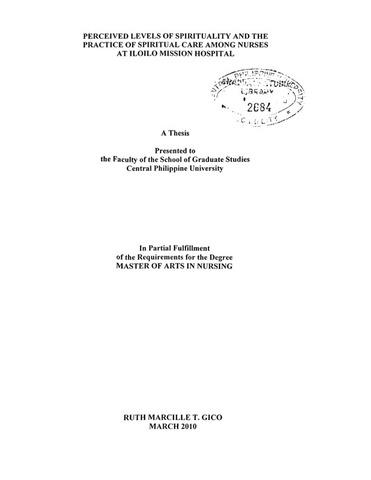Показать сокращенную информацию
Perceived levels of spirituality and the practice of spiritual care among nurses at Iloilo Mission Hospital
| dc.contributor.adviser | Delicana, Lilia A. | |
| dc.contributor.author | Gico, Ruth Marcille T. | |
| dc.date.accessioned | 2021-03-03T08:25:20Z | |
| dc.date.available | 2021-03-03T08:25:20Z | |
| dc.date.issued | 2010 | |
| dc.identifier.citation | Gico, R. M. T. (2010). Perceived levels of spirituality and the practice of spiritual care among nurses at Iloilo Mission Hospital (Unpublished Master's thesis). Central Philippine University, Jaro, Iloilo City. | en_US |
| dc.identifier.uri | https://hdl.handle.net/20.500.12852/547 | |
| dc.description | Abstract only | en_US |
| dc.description.abstract | A descriptive-relational study on the perceived levels of spirituality and the practice of spiritual care of Nurses at Iloilo Mission Hospital was done using a one-shot survey design. The respondents of the study were 104 nurses employed as regulars at Iloilo Mission Hospital. The items in the research instrument used in this study were combined questionnaire items taken from the study entitled “Spirituality in Higher Education: A National Study of College Students’ Search for Meaning and Purpose” (2003) conducted by the Higher Education Research Institute (HERI) at the University of California Los Angeles (UCLA), and one on Patient Care done by the American Association of Critical Care Nurses Synergy Model. Other items were researcher-made to fit the culture of Filipino nurses. The statistical tools used were the frequency count, percentage and the mean for descriptive statistics while Chi-square was used to test for analysis of relationships. The level of significance for the test of hypothesis was set at 0.05. The findings disclosed that most of the nurses employed at Iloilo Mission Hospital are young with an average age of 26, female, single, coming from sectarian schools and are moderately involved in religious activities. As a whole, no significant relationships were found between demographic characteristics and perceived levels of spirituality; and demographic characteristics and practice of spiritual care. However, the Chi-square test revealed a significant relationship between sex and ethic of caring. Likewise, a significant relationship was found between religious involvement and practice of spiritual care. Furthermore, the Chi-square result also indicated that there is a significant relationship between perceived levels of spirituality and practice of spiritual care at 0.05 level of significance. It can be concluded that the practice of spiritual care relies on the nurse’s personal convictions and spiritual perspectives, thus rejecting the null hypothesis which states that there is no significant relationship between perceived levels of spirituality and practice of spiritual care. Thus it is suggested that (1) nurses must be encouraged to develop their own spiritual lives as this would assist them in providing holistic care to their patients through trainings and seminar workshops; (2) Iloilo Mission Hospital must be knowledgeable of the spiritual awareness of their entire personnel and not just of the nursing workforce to maintain the quality of care given to its clients in terms of holism; (3) nurse educators must include the discussion of spirituality, spiritual assessment and care within the nursing curricula, since, its integration can facilitate spiritual care; (4) health care administrators and nurse managers must create an environment that ensures the cultivation of the spiritual lives of the nurses and at the same time, a place that promotes the systematic provision of spiritual care to patients; (5) Human Resource Department must create programs and trainings that promote spirituality not just among nurses but to the entire hospital workforce as this could help in the advancement of the welfare of their employees in terms of holism; and, (6) a further study on this topic be done, delving more on spirituality and its different aspects and considering other variables that could affect one’s spiritual perceptions. Also, a similar study is suggested for nurses of other hospitals and student nurses of different schools. | en_US |
| dc.format.extent | ix, 98 leaves | en_US |
| dc.language.iso | en | en_US |
| dc.subject.ddc | GSL Theses 610.73072 G359 | en_US |
| dc.subject.lcsh | Spiritual care (Medical care) | en_US |
| dc.subject.lcsh | Nurses | en_US |
| dc.subject.lcsh | Nursing | en_US |
| dc.subject.lcsh | Spiritual life | en_US |
| dc.subject.lcsh | Spirituality | en_US |
| dc.subject.lcsh | Spirituality--Health aspects | en_US |
| dc.subject.lcsh | Nursing--Practice | en_US |
| dc.subject.mesh | Spiritual Therapies | en_US |
| dc.subject.mesh | Spirituality | en_US |
| dc.subject.mesh | Nursing | en_US |
| dc.subject.mesh | Nurses | en_US |
| dc.title | Perceived levels of spirituality and the practice of spiritual care among nurses at Iloilo Mission Hospital | en_US |
| dc.type | Thesis | en_US |
| dc.description.bibliographicalreferences | Includes bibliographical references | en_US |
| dc.contributor.chair | David, Fely P. | |
| dc.contributor.committeemember | Somo, Lily Lynn V. | |
| dc.contributor.committeemember | Lamasan, Nelida L. | |
| dc.contributor.committeemember | Abioda, Nenalyn D. | |
| dc.contributor.department | School of Graduate Studies | en_US |
| dc.description.degree | Master of Arts in Nursing | en_US |
| local.subject | Iloilo Mission Hospital (IMC) | en_US |





